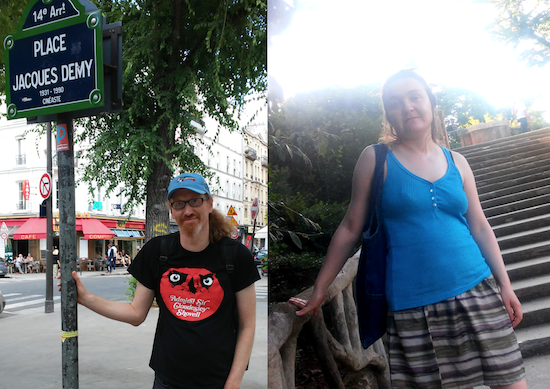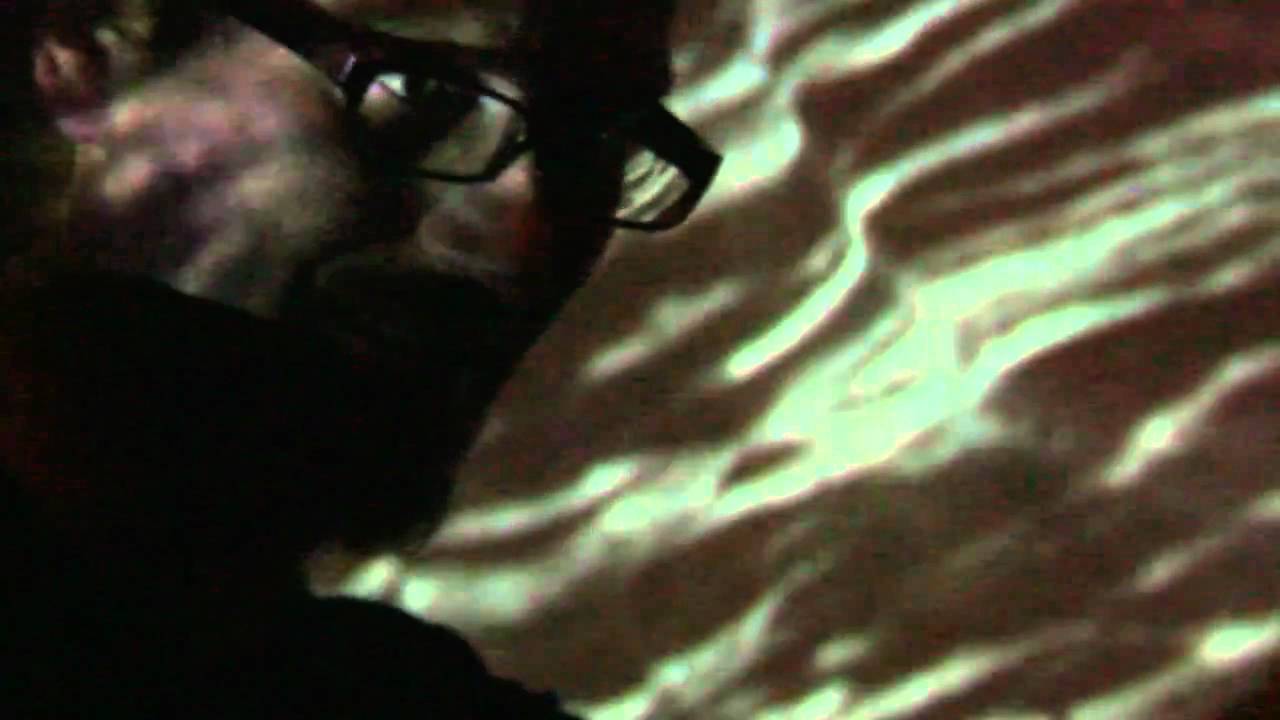Band portrait courtesy of Ashtray Navigations
"We were always too rock for the art crowd and too artsy for the rock & roll crowd," admits Phil Todd, founder of long-running Stoke-on-Trent-born and Leeds-based psychedelic avant-rock band Ashtray Navigations, flickering in and out of the fractured image of a lousy Skype connection. "I’ve always been a big fan of playfulness. I take great pleasure in the unexpected and illogical aspects of recording music."
Formed in 1991 by Todd, and joined by Todd’s musical/life partner Mel Ó Dubhshláine in the 2000s, Ashtray Navigations have produced an immensely vast discography (he doesn’t think anyone in the world owns every Ashtray Navigation release, not even himself) of music that can’t be described as anything less than gloriously expansive and multilayered. Drone, noise, psychedelic rock, folk, Middle Eastern flourishes, and more are condensed into an unmistakably transgressive sound.
Ash Nav, as the band is colloquially referred to, is psychedelic in a way that has less to do with a specific genre and more to do with something uncanny and unnameable. Their music isn’t psychedelic rock to be written off as loud, wah wah pedal-driven distorted speed rock. Instead, Ashtray Navigations are psychedelic in the way that the 36-minute live version of ‘Sister Ray’ on The Velvet Underground’s The Complete Matrix Tapes is, or the way that Plastikman’s ‘Consume’, with its macabre atmospherics and eerie beats, is. Genuinely exploratory and "playful," as Todd indicates, this is psychedelic music that takes you beyond material reality into an interzone of the unknown where physical and spiritual limits deteriorate and anything becomes possible.
"[German avant-garde vocal artist] Mik Quantius described psychedelic music as ‘music in 3D’," says Todd. "There’s a different dimensionality to it. And once you define it in this way, any style of music can be psychedelic so long as it has that third-dimensionality to it." VHF Records has released a 4-CD box set compilation of archive material, commemorating the group’s 27th anniversary. Entitled Ashtray Navigations Greatest Imaginary Hits, the compilation works as a potent entry point into this transcendentally chaotic musical universe.
The band opted for a specific approach to the compilation. A labour of love, four "curators" were selected to choose their favourite Ashtray Navigations tracks, one for each disc of the compilation: Vibracathedral Orchestra founder and long-time Ash Nav collaborator Neil Campbell, Radio Free Midwich founder and coiner of the term "no audience underground" Rob Hayler, writer and underground music bootlegger Pete Coward, and none other than Ash Nav superfan Henry Rollins himself.
Ashtray Navigations Greatest Imaginary Hits functions as a testament to the rewarding personal relationships that Ash Nav fans form with the band and their sonically varied music. "We were worried about the possibility that two or more people might pick the same track," says Ó Dubhshláine. "But nobody did. Everyone had an entirely different list."
The compilation unearths vast potentialities and contradictory aesthetics that coagulate and blur into something unmistakably, joyously Ash Nav, with each curator’s tracklist almost accidentally isolating the various styles that have all defined the Ashtray Navigations sound. On Rollins’ disc, you will hear songs like ‘Tapwater Locomotive Pt. 3’ that capture the group at its most libidinally rock & roll.
Campbell’s selections, like ‘Trashcan Antidote 2’, are emblematic of Ash Nav’s occasional tendency towards a fractured synth-driven transcendence. Ash Nav’s disposition towards existential murk and syrupy noise are all over Hayler picks like ‘Deflection Music For Warheads’. While there are sonic diversions on all these discs that break the aesthetic trends, the curatorial style emphasises Ash Nav fandom as a zone of freedom and aesthetic individuation nonetheless: "I typically don’t like listening to these tracks in isolation," says Todd. "Because I’m well into sequencing and having different moods on an album offset each other. But this compilation really works."
The multiplicity in texture that defines the seductive amorphousness of Ash Nav’s sound is less the sum of a direct intentionality than it is the result of a vague conceptual process and a labour relation, for lack of a better term. Todd never set out to create anything as specific as "lo-fi transcendent rock" or "avant psychedelia" so much as he wanted to create something dense and original more broadly.
There’s a quote about Ash Nav on the internet that has apparently been misattributed to writer and musician David Keenan (Todd and Dubhshláine found out this quote in their press junket was misattributed years ago, and to this day haven’t managed to learn who wrote it) that says the band was like a "trashcan antidote to LaMonte Young." Though the misattributed phrase is certainly interesting, it fails to adequately describe the magnitudes of possibilities within the sound; the only direct connection that Ash Nav have with drone music for instance is as an outgrowth of the limited means of production that Todd had at his arsenal when he started the project.
"The early drone connection comes from the way the songs were produced," says Todd. "I started with a four track recorder, and without a compositional structure I would have to start a track with something, so I always started with a drone."
This process has evolved with the band’s increasingly improved gear and compositional skills. The drones that used to function as the base for the band’s songs have largely been replaced by foundational rhythms. But whatever the base might be, it’s more important to understand the band’s unique method than it is to focus on the isolated components that comprise said technique. Todd calls this a "vertical approach" rather than a horizontal one: "It’s a layering of sounds as opposed to a blending of sounds," muses Todd. "A lot of people think Ashtray Navigations are totally formless, but that confusion comes from our arranging form vertically as opposed to horizontally."
Throughout the interview, Todd references artists and filmmakers that could be said to create art by appropriating, perverting, and "vertically arranging" the signifiers of mass culture, genre-based media: the late experimental film pioneer Jeff Keen, obscure horror and sci-fi filmmaker Lucile Hadžihalilović, and most importantly the artist, photographer, and pioneer of New York underground cinema Jack Smith among them. These artists are arguably more germane to consider when attempting to comprehend the mystique of Ash Nav than the assorted musical influences that Todd and Dubhshláine hold dear.
While there’s no question that musically-related things like Sun Ra, Spacemen 3 live shows and Indian classical music play a part in the Ash Nav aesthetic, it’s the ways in which the band treats their influences — these various genres — as formulas to be placed into a witch’s cauldron and cooked into a uniquely delirious and phantasmagoric potion of a sound that makes them an uncommonly idiosyncratic group. It’s a technique that facilitates the liquidation of a vast array of genres and influences into the radical form that is showcased in all its multitudes on Imaginary Hits. "The way Jack Smith would use the texture of genre and this almost dated look that made something grand in scope with limited means of production was deeply influential on Ashtray Navigations," says Todd.
For Ash Nav, genre isn’t exactly obsolete so much as it presents forms that can be de-sublimated and manipulated to create something new. This partly explains why they can be so difficult to apply generic signifiers to. It’s not quite noise, nor is it quite psychedelic rock, nor is it quite freak folk; but it is all of these things at once.
The 1990s were rife with great bands that blurred boundaries between rock & roll and the avant-garde. There were Japanese bands like Fushitsusha and Mainliner, chaotic British bands like Walkingseeds and Ceramic Hobs, and many more that all walked that tight rope. But Ash Nav perhaps more than any other band of this kind prove exceedingly classification-averse. With both disorienting and fragmented noise, and Todd’s cheeky but impressive guitar solos, this is a band that truly exists on the borders of styles. "People always have different responses to an Ashtray Navigations show," says Dubhshláine. "Sometimes people are moshing out like it’s the craziest thing they’ve ever heard, and other times we end up being billed as the ‘chill out’ band at a noise show."
Between their genre fluid approach to avant-garde music, their vast discography, and Todd’s unique approach to graphic art that seems to splice the DNA of psychedelic poster art with 20th century outsider and Dadaist influences, becoming an Ash Nav fan feels like entering an alternative universe of ecstatic artistic freedom. Ash Nav moved from Stoke-on-Trent to Leeds in 2001, and it’s hard not to at least partly credit the group’s presence in Leeds with the eventual emergence of what Gutternsipe’s Gretchen has called a "Genuine ‘freak scene’, a close-knit community of arty, punk, weirdo types who have a real DIY ethic."
Being within the domain of Ash Nav is inspiring; it’s like immersing yourself in a boundary-less creative sphere where all music is celebrated and de-territorialised. Dubhshláine herself studied visual art all the way through her MA, and found the art world so hideous and antithetical to creativity that she soured on art all together. Ashtray Navigations revitalised her passion. "I couldn’t even enter an art gallery without getting sick," she laments. "But when I hooked up with Phil in Stoke, I was convinced that what Ashtray Navigations was doing was real art. Everything else seemed anaemic and over-conceptualised by comparison."
Greatest Imaginary Hits is out now on VHF



